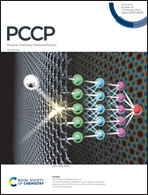Dynamics and kinetics of the OH + HO2 → H2O + O2 (1Δg) reaction on a global full-dimensional singlet-state potential energy surface†
Abstract
The OH + HO2 → H2O + O2 reaction is a prototype of radical–radical reactions, which plays an eminent role in combustion and atmosphere chemistry. Extensive studies have been focused on the ground triplet electronic state, but investigation on the singlet excited state is rare. Here, we report a full-dimensional singlet-state potential energy surface (PES) for this reaction, which was constructed using the fundamental invariant neural network (FI-NN) fitting to roughly 130 000 energy points calculated by the CASPT2/AVTZ method. Extensive quasiclassical trajectory (QCT) calculations were performed on the FI-NN PES in a wide range of collision energies and temperatures. The pathway via a shallow minimum with a direct abstraction mechanism is identified as a dominant reaction path due to a low barrier, with most available energy released into the rovibrational motion of the products, and angular distributions showing predominantly backward and sideways scattering amplitudes. The QCT thermal rate coefficients on the singlet-state PES show small, but non-negligible contributions to the overall rate of the OH + HO2 reaction.



 Please wait while we load your content...
Please wait while we load your content...